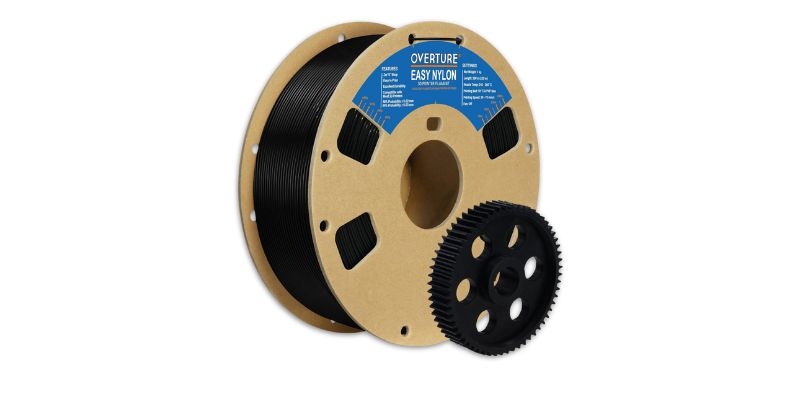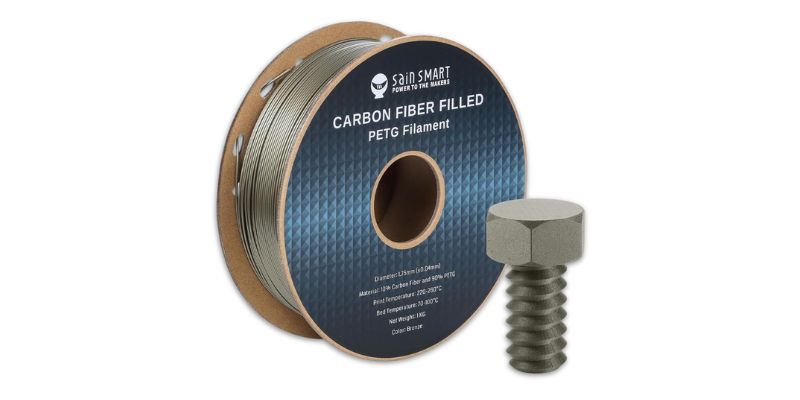To help you find the right filament for your next project, we are going to take a closer look at the different types available and find the right kind of strong 3D printer filament for your needs.
The Strongest Filaments
Some of the strongest 3D printer filaments include:
1. Polycarbonate (PC)

Pros
- Great strength and impact resistance — commonly used in robot combat and other uses.
- High thermal resistance.
Cons
- Very difficult to print as it requires such high temperatures.
- Requires metal hot end and an enclosure.
PC is absolutely one of the strongest filaments available: it’s used to make bullet-proof glass, motorcycle helmets, and riot gear.
It’s often used for printing phone cases due to its strong impact resistance. It is also known for its optical clarity, which is why it can be used to print scuba masks.
For heat resistance, the British Plastics Federation says it can maintain rigidity up to 140°C, and toughness down to -20°C. Because of this, it won’t break down and become less solid until it reaches a temperature that is higher than a lot of the alternatives.
Polycarbonate prints can be bent at room temperature without cracking or breaking and don’t show signs of wear even after many uses.
Its impact strength is arguably its greatest plus point. Even though it is so lightweight, it is far stronger than acrylic and is a great transparent alternative. This is because its impact resistance is 250 times that of glass.
To put its strength into numbers, AC Plastics Inc confirm that it has a tensile strength of 9,500 psi, meaning it can withstand the equivalent pressure of being around 20,000 feet underwater before suffering any signs of breakage.
2. PEEK

Pros
- Incredibly strong – metal level strength but much lighter.
- Sterilizable – which gives it useful medical applications, such as in implants.
Cons
- Extremely expensive.
- Very hard to print – requires specialized high-temperature printers.
PEEK (Polyether Ether Ketone) is expensive, but is one of the strongest 3D printable materials around, despite being so lightweight.
This makes PEEK resistant to chemical, organic, and biodegradation in a way that other materials cannot match.
Because this filament doesn’t absorb as much moisture as other filaments, it can be sterilized easily, making it a popular option for medical fields and food-grade products.
PEEK is used to manufacture custom implants. Since it has similar properties to human bone, PEEK can encourage tissues to reconstruct around the implant, enhancing the limb replacement process. It’s also used for cosmetic procedures, with patients having 3D printed PEEK implants created for chin and cheek implants for a more defined lower face, as well as in reconstructing faces of patients with facial cancers.
Read more: the best PEEK 3D printers
3. Nylon (PA)

Pros
- Strong and slightly flexible, which boosts impact resistance.
Cons
- Very hygroscopic – needs to be stored in a dry environment.
- Warps if not printed under the right conditions.
A popular and strong filament used in 3D printers, Nylon, also known as Polyamide (PA), is known for its great tensile strength, reaching up to 7,000 PSI.
It is highly heat- and chemical-resistant, making it an excellent all-rounder. Because it has enough give in it to bend a little without breaking, it is useful for making mechanical parts such as gears and functional prototypes such as tools.
Nylon is often combined with fiberglass and carbon fibers to create composite filaments with increased strength.
The way it melts means Nylon has excellent layer bonding and will remain strong no matter how tall the print is. This ensures layer separation does not become an issue, ruining a lengthy print process.
But much like any filament, Nylon has its flaws. It is hygroscopic, and as a result, it needs to be kept in airtight filament storage. Otherwise, it could warp during printing. It also needs temperatures that exceed 250°C.
With a thermal resistance of up to 120ºC, Polyamide remains strong even when exposed to high temperatures for an extended period. If your print will be exposed to heat, Nylon is a great option.
It has a semicrystalline structure, which means it will remain solid until a certain quantity of heat is absorbed. Because of this, Nylon is a versatile filament, commonly used to print parts that are exposed to different environments, especially those with high heat.
Use it to make manufacturing materials such as bearings, nuts, washers, and handles, where it can be exposed to abrasion, heat, and even heavy impacts.
Read more: the best Nylon 3D printers
4. Carbon Fiber Composite Filament

Pros
- Super strong yet lightweight
Cons
- Will destroy any brass or softer material nozzles
- Generally expensive
Composite filaments are made up of more than one material. For example, combining PETG, Nylon, or PLA with carbon fibers.
Carbon fiber is generally the best composite filament for 3D print strength. Using thin carbon fibers produces strong yet light prints. This are advantageous in sports, and is used in tennis rackets, softball bats, golf clubs, hockey sticks, as well as on virtually every competitive bike.

While most base plastic is weakened by the addition of a second material, carbon fiber is the exception. MatterHackers proved this when they printed hooks with carbon fiber infused nylon, and glass infused nylon filament (NylonG), and found they could hold 349 and 268 pounds on average.
Experts say that carbon fiber composite can be 42% lighter than aluminum and has almost no thermal expansion.
5. ABS

Pros
- Strong despite low cost.
- Lack of chemical resistance gives it useful applications.
Cons
- Warps without an enclosure.
- Good heat resistance.
ABS also known as acrylonitrile butadiene styrene, is a high-impact resistant filament. This is why it is commonly found in technical prints such as moving parts likely to come under high stress during use.
Commonly found in plumbing parts and food processing components, It is a decent all-rounder offering a mix of impact, heat, and chemical resistance.
Although PLA has a greater tensile strength compared to ABS (7,250 psi vs 4,700), PLA has poor heat resistance. Because of this, ABS can be better for making prototypes.
Softening at 105ºC, ABS has decent heat resistance, but due to its susceptibility to warping and cracking, it is harder to print than PLA. To make warping less likely, use a heated print bed as ABS contracts when cooled.
It remains a cost-effective choice compared to a lot of the alternatives. So, if you need high-strength and quality prints with a pleasant finish, all without the hit in the pocket, ABS is a good option.
What Are The Different Types Of Filament Strength?
| Property | PC | PEEK | Nylon* | ABS | PETG CF | Nylon CF |
|---|---|---|---|---|---|---|
| Tensile strength (MPa) | 60 | 170 | 79.29 | 44.81 | 52.9 | 63 |
| Impact strength** (J/cm) | 0.250 | NA | NA | 0.38-10.3 | NA | 0.25-2.67 |
| Flexural strength (MPa) | 100.4 | 68 | 103.42 | 75.84 | 80 | 142 |
| Elongation at break (%) | 12.24 | 10-50 | 50 | 10-50 | 3 | 1.00-20.0 |
| Shear strength (MPa) | NA | 23.96 | NA | NA | NA | NA |
| Compressive strength (MPa) | 82.74 | 117.21 | 86.18 | NA | NA | NA |
| Abrasion resistance | NA | NA | NA | NA | High | NA |
| Heat resistance (°C) | 110 | 260 | NA | 110 | 100 | High |
| Filament | Chemical resistance |
|---|---|
| PC | Polycarbonate (PC) exhibits resistant properties to a broad spectrum of substances, notably saturated, aliphatic, and cycloaliphatic hydrocarbons, alcohols, oxidizing and reducing agents, certain solutions, and a variety of greases, waxes, and oils. Those substances are listed here. |
| PEEK | It has been demonstrated that PEEK is resistant to a variety of organic and inorganic substances. Those substances are listed here. |
| Nylon* | Nylon is in general chemically resistant to alkalis, weak acids, and oxidizing agents. |
| ABS | Certain acids, chlorides, salts, chemical solutions, wetting agents, and water have no impact on ABS. Chemicals that ABS is resistant to, are listed here. |
| PETG CF | NA |
| Nylon CF | NA |
Data for the tables above were compiled from these sources
- MatWeb
- Fiberlogy
- K-mac Plastics
- Science Direct
- SciELO
- Stratasys
- Formlabs
- AT Machining
- Ensinger
- M3D
- Laminated Plastics
Tensile Strength
Known as the max load an object can support before it breaks. This is going to be useful for weight-bearing prints such as hooks. Common materials such as PLA may surprise you with their 7,250 psi strength, but there are plenty of stronger options better suited to different applications.
Impact Resistant
When two objects collide you need to know your print is not going to break. It could also be described as its toughness, but anything that is overly brittle will likely be damaged when dropped.
Chemical Resistance
Is your filament going to degrade once it is exposed to chemicals? Any 3D print that may come into contact with acids or solvents will need to offer higher chemical resistance.
ABS is famously susceptible to acetone, which is commonly used to give your prints a sleek shine, but often you want your prints instead to resist chemicals.
Temperature Deflection
This is the temperature that a material can withstand before it starts to deform. Any printed object that is going to be exposed to high temperatures, be it from friction or direct, will need to have high-temperature deflection.
Why Is This Important?
Everyone has different needs, but luckily there is always a filament to match. Anyone 3D printing toys for example will need filament that is impact resistant. That way, it can withstand a bit of harsh treatment from young children.
If you are printing food containers and liquid bottles you will need heat-resistant filament and certain options that are far better for this.
Some filaments offer better elongated strength. Like rubber, this means they can bend further before they might break. Anyone making phone cases will need to find a filament that can be bent a little to fit around a phone.
We’re going to consider each of these areas, and take a look at the strongest 3D filament to make sure you end up with the ideal material for your next print.
Other articles you may be interested in:





